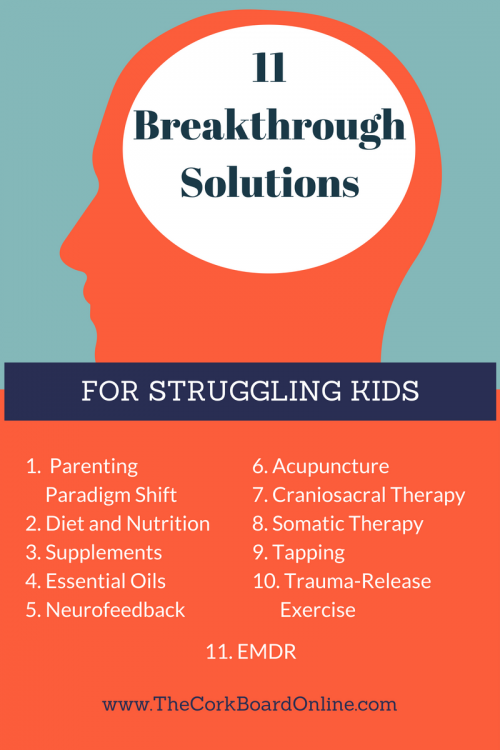Before parenting children with challenges, I had a pretty bare toolbox. The learning curve after our first adoption was steep. During our journey, we’ve researched and learned a lot. It started with some simple parenting shifts. Then we learned that there is a fascinating mind-body connection. This opened a world of other things to try. Let this post be a jumping off point for your research as you continue to support your child.
Parenting Paradigm Shift
Sometimes a makeover of your parenting toolbox is enough to radically change a family’s trajectory. I love working with families and helping them go from weary and deflated to thriving and hopeful. To find out if receiving parent coaching is a good fit for your family, book a free virtual coffee by clicking here.
Additional resource: Understanding Challenging Behaviors (a free download)
Diet and Nutrition
Children from hard places often have over-worked amygdalas (the brain center that controls our survival response) which means that their digestive system is not getting the resources it needs.[1] Their bodies may not be equipped to handle harder-to-digest foods such as dairy and grains and may not process out toxins such as added dyes and preservatives. Some foods also cause brain inflammation which can exacerbate trauma-related behaviors. Try focusing on whole foods–specifically grass-fed, free-range meats; wild-caught fish, veggies, walnuts, and seeds.
Additional resources: Anti-inflammatory foods, Feingold Diet.
Supplements
Based on our soil conditions, lifestyle, and increased toxic load, everybody probably needs some form of supplementation, but that’s a soapbox for another day. Specifically, children from hard places need high amounts of Omega-3’s. Liquid fish oil is best. The best tasting and easiest to hide in yogurt or smoothies is doTERRA’s IQ Mega®. Additionally working with a holistic practitioner to balance your child’s neurotransmitter levels with amino acid supplements is a great way to support your child’s body to be in the best place to be able to heal emotionally.
Essential Oils
Because of their interaction with olfactory sensors which impact our autonomic nervous system, essential oils can have a profound impact on our emotional state. [2] Additionally, clinical application methods can make touch approachable for children who find affectionate touch triggering or too intimate. To schedule an appointment to learn about essentials oil and therapeutic touch, click here.
Additional resource: Essentially Connected Parenting FB Group
Neurofeedback
Neurofeedback, a type of biofeedback, is a brain-based treatment that uses a sophisticated brain-computer interface (BCI) to “strengthen” or retrain the brain.[3] An AAP Level 1 treatment modality for ADHD, neurofeedback also has shown efficacy in improvements of PTSD symptoms. [4][5] Using neurofeedback to improve sleep and brain regulation can often open up the doors for the child to be more responsive to other tools.
Additional resource: BCIA Practitioner Search
Acupuncture
A form of Chinese medicine, acupuncture can reduce anxiety and may help symptoms of PTSD. [6][7]
Craniosacral Therapy
This type of touch therapy gently manipulates the joints of the cranium. It is often used to help the body process trauma.[8][9]
Somatic Therapy
Intergrating techniques such as mindfulness, touch, breathing, and movement, Somatic Therapy can reframe past negative experiences and help the patient feel more free and less stressed.[10]
Tapping
Also called the Emotional Freedom Technique (EFT), tapping is a psychological acupressure modality that can help remove negative emotions and optimize one’s emotional health.
Additional Resource: DIY Videos from Dr. Mercola
Trauma-Release Exercise (TRE®)
This is an innovative series of exercises that assist the body in releasing deep muscular patterns of stress, tension and trauma. Created by Dr. David Berceli, PhD, TRE® safely activates a natural reflex mechanism of shaking or vibrating that releases muscular tension, calming down the nervous system. When this muscular shaking/vibrating mechanism is activated in a safe and controlled environment, the body is encouraged to return back to a state of balance. [11]
EMDR
EMDR (Eye Movement Desensitization and Reprocessing) is a psychotherapy that enables people to heal from the symptoms and emotional distress that are the result of disturbing life experiences.[12] While EMDR can require a level of initial stability, it is a powerful way to find freedom from past traumatic experiences. Some practitioners can even work with non-verbal children. For more information and practitioner listings, visit EMDR.com.
I found this list of strategies that I'm excited to try for my kids. #parenting Click To TweetThe hardest part of having so many choices is deciding where to start. Regardless of what you decide may be an effective fit for your family, try to limit yourself to one change a month. Sometimes it takes a while for the body to transition. Frantically, jumping from one experiment to another can actually cause more upheaval in your life. Also, remember that sometimes the most effective thing we can do is try these things for OURSELVES as the parent or primary caregiver. Taking care of our emotional state can often give our kids a light to follow.
